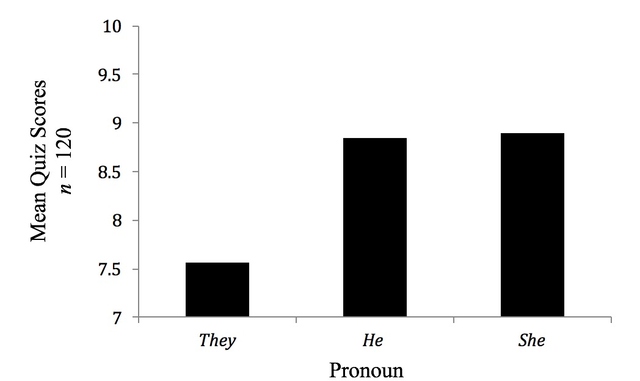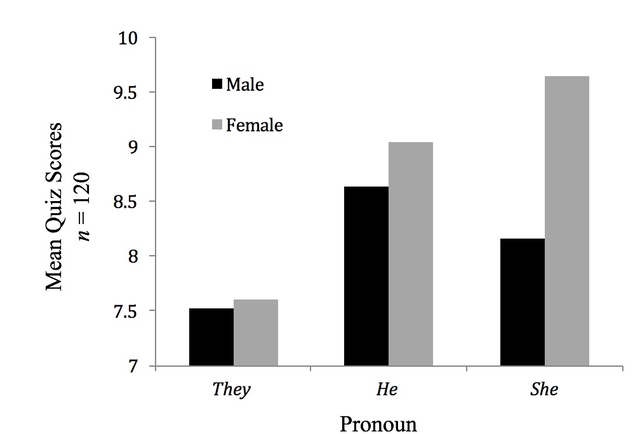Featured Article:One Pronoun at a Time: Gender-Specific Pronouns Improve Reading Comprehension
By
2018, Vol. 10 No. 02 | pg. 1/1
IN THIS ARTICLE
KEYWORDS
AbstractThe current study focuses on the effect of gender-specific (he, she) and gender-neutral (they) pronouns on male and female recognition ability. Crawford and English (1984) showed male pronouns (he) better aid male recall and gender-neutral pronouns (they, he or she) better aid female recall. The effect of female pronouns (she) on recall ability was not studied (Crawford & English, 1984). The current study recognizes this gap and extends Crawford and English’s (1984) study to include female pronouns. 151 participants (75 male, 75 female, 1 unidentified) were identified via convenience sampling and a balanced number of males and females were randomly assigned to 1 of 3 reading conditions (he, she, or they). Participants were given 15 min to read Charles Johnson’s ‘Moving Pictures’ (Cassill & Bausch, 2000), altered from its’ original, second-person, tense (you) and rewritten in he, she, and they tenses. Participants, then, completed a related 13-question, multiple-choice test in the consistent tense and indicated their gender. A two-way ANOVA showed significantly (p = .008) reduced test performance for both male and female participants in the gender-neutral condition. No significant interaction (p = .311) existed between participant gender and pronoun condition. Contrary to previous research (Crawford & English, 1984; Good, Woodzicka, & Wingfield, 2010), there was no difference in test performance, irrespective of gender (p = .096). The current study’s findings showed gender-specific pronouns, versus gender-neutral pronouns, promote clarity and recognition in writing. A research article must be written clearly and concisely to best convey a study’s findings. Authors are asked to use a specific writing format whether it be APA, MLA, or Chicago, so that a professional in their field will understand the information being presented. Although not often used in research articles, the role pronouns play in creating clarity or confusion was of special interest. The current study aimed to understand how the use of gender-specific (he, she), and gender-neutral (they), pronouns impact multiple-choice test performance. Previous studies answered similar questions, but did so in different social atmospheres. Crawford and English (1984) studied the effect of “generic” versus “female-inclusive” pronouns on recall ability after reading an informative essay. “Generic” pronouns within Crawford and English’s (1984) study included what the current study deemed male-specific (he, his, him). Additionally, “female-inclusive” pronouns within Crawford and English’s (1984) study included what the current study deemed gender-neutral (they, he or she). Crawford and English (1984) found males recalled information more accurately when “generic” pronouns were present and females recalled information more accurately when “female-inclusive” pronouns were present. The current study addressed the absence of a female-specific pronoun condition in Crawford and English’s (1984) study and, thus, included a female-specific pronoun condition. Due to changes in social awareness between Crawford and English’s (1984) study and today, female-specific pronouns were assigned to a separate condition in the current study as it is no longer acceptable to use ‘generic’ pronouns to identify women.An acceptable gender-neutral pronoun was determined through a literature review. Male-specific pronouns are no longer socially acceptable to convey gender-neutrality (Gastil, 1990; Moulton, Robinson & Elias, 1978). These findings indicated male-specific pronouns could not be considered as unbiased, all-inclusive, pronouns to use in the current study’s gender-neutral condition (Gastil, 1990; Moulton et al., 1978). Madson and Hessling (1999) examined how alternating he and she and using he or she throughout an essay impacted essay readability. Researchers found he or she distracted participants and alternating he and she caused participants to feel the reading was biased against men (Madson & Hessling, 1999). These results indicated neither of these were appropriate gender-neutral pronoun phrases to use as avoiding bias and confusion in the gender-neutral condition was a priority. Madson and Shoda (2006) conducted a similar study to Madson and Hessling (1999) and found similar, and supplementary, results. Madson and Shoda (2006) examined the impact of reading topic on participant opinion of pronoun use. Three different essays - one about a typically masculine topic, one about a typically feminine topic, and one about a gender-neutral topic - were read by participants, each existing in four separate versions (Madson & Shoda, 2006). One version alternated between masculine and feminine pronouns, the second used paired pronouns (he or she), the third used only she, and the fourth used only he (Madson & Shoda, 2006). Unless the essay was written on a feminine topic, participants believed she appeared more often than he, indicated the essay was of lesser quality than the essays using masculine pronouns, and felt the essay was biased against men (Madson & Shoda, 2006). These results indicated alternating between he and she in the current study would appear biased (Madson & Hessling, 1999; Madson & Shoda, 2006). Conkright, Flannigan, and Dykes (2000) studied children’s recall of imaginary stories. Participants included 48 boys and girls aged 6 and 9 (Conkright et al., 2000). All characters in the stories had ambiguous names and the independent variables included the activity the character performed and which pronoun the character was referred to as (Conkright et al., 2000). The three activities were either stereotypically gender-neutral, masculine, or feminine and the pronouns were he, she, they, or alternating he/she (Conkright et al., 2000). Each child was read eight stories and, then, asked to answer questions about the story (Conkright et al., 2000). Participants were asked to recall everything they could and were also asked to recall particular information (Conkright et al., 2000). Participants were also asked to indicate the gender of the character and explain how they came to that conclusion (Conkright et al., 2000). Both male and female participants recalled more information when the characters were referred to as she (Conkright et al., 2000). When he, she, or he or she were used, participants based the gender of the character on the pronouns (Conkright et al., 2000). When they was used, however, participants based their reasoning on the activity of the characters in the story and on the pronoun (Conkright et al., 2000). These findings indicated they was the ideal pronoun to achieve gender-neutrality because they did not bias the participants’ opinions of the character’s gender. Further research was conducted to determine the impact of gender on recognition ability. A recent study by Good, Woodzicka, and Wingfield (2010) revealed there was a significant difference in comprehension when males and females were presented with images, within a reading, matching their gender versus matching another gender. Researchers assigned 81, 9th and 10th graders to one of three image conditions (Good et al., 2010). The first condition contained three images of males performing scientific tasks, the second condition contained three images of females performing scientific tasks, and the third condition contained three images of an equal amount of males and females performing scientific tasks (Good et al., 2010). Researchers found males performed significantly higher on a test about the corresponding science material when male images were present in the reading and females performed significantly higher when female images were present in the reading (Good et al., 2010). Good et al. (2010) showed female and male recognition was significantly influenced by images matching their gender. Findings of previous studies (Crawford & English, 1984; Good et al., 2010) indicated the likelihood of a difference between male and female multiple-choice test performance. Due to the possibility of a difference between male and female recognition ability and an interest in providing readers with the most clear and concise pronouns, it was hypothesized a pronoun matching participant gender, would lead to higher scores on the multiple-choice test. MethodologyThe current study examined whether gender-specific and gender-neutral pronouns within a short story have an effect on multiple-choice test scores. The independent variable in the current study was the pronoun (he, she, or they) used. The participant variable of gender (male, female) was also considered. The dependent variable was the participant’s multiple-choice test score (potential range 0-13). ParticipantsPurposive sampling was used to identify 151 undergraduate participants (75 male, 75 female, 1 unidentified), aged 18 and up, with the constraint that an equal number of males and females needed to participate in each pronoun condition. MaterialsEach participant received a #2 pencil, a consent form, a 13-question, multiple-choice test including a gender self-report (see Appendix A), and one copy of Charles Johnson’s Moving Pictures (1985). The multiple-choice test was created for the purpose of this study based on the content of the short story with questions centering around the protagonist. All materials provided to participants were returned to the researcher at the conclusion of each data collection session. ProcedureParticipants were informed the study focused on undergraduate reading comprehension, but to minimize distraction, were not informed of pronoun importance. Readings were distributed after being randomized to ensure random assignment. This process was completed using an online randomizer website (Urbaniak & Plous, 2013), inputting the number of expected participants, and clicking ‘randomize.’ The randomizer’s output was a number from 1-150, placed in random order, which were then applied to the readings before distribution. Participants read the story for 15 min in one of three pronoun conditions (he, she, or they) in which all pronouns, and corresponding verbs, within the reading were changed to match the condition. For example, an original sentence in Charles Johnson’s Moving Pictures read, “Naturally, you have left your life outside the door” (1985, p. 814). This sentence was changed to “Naturally, he/she/they has/have left his/her/their life/lives outside the door.” Participants who completed the reading before the 15 min expired were instructed to re-read the short story. After the 15 min elapsed, readings were collected and exchanged for a multiple-choice test on the reading, which also included a gender self-report. Multiple-choice tests were collected as participants completed them. Participants were debriefed with an explanation including the study's purpose. Participation in the current study was rewarded with research credit. ResultsThe three levels of the independent variable were the pronouns he, she, and they used within a short story. Gender (male, female) was considered as a participant variable. The dependent variable was participant score on a multiple-choice test. Data collected from the participant who did not identify their gender was not analyzed. Data were sorted by pronoun reading condition and gender. Results were assessed using a two-way ANOVA (α = .05). The two-way ANOVA examined for two main effects and one interaction. The main effects considered were (1) whether there was a mean difference among multiple-choice test scores by pronoun condition and (2) whether there was a mean difference between male and female multiple-choice test scores. The interaction considered was whether pronouns interacted with gender to produce a significant difference in multiple-choice test scores. The first main effect considered showed significantly (p = .008) reduced multiple-choice test scores in the gender-neutral condition relative to gender-specific conditions (see Figure 1). The second main effect showed no significant (p = .096) difference between gender and multiple-choice test score and no significant (p = .311) interaction occurred between participant gender and pronoun (see Figure 2). Figure 1. Mean quiz scores for each of the three pronoun conditions (they, he, she). Gender-specific pronouns produce significantly (p = .008) different multiple-choice test scores. Figure 2. Mean quiz scores for each of the three pronoun conditions (they, he, and she), with regard to gender. No significant difference (p = .096) occurred between male and female multiple-choice test scores. DiscussionThe results of the current study permit rejection of the null hypothesis and acceptance of the alternative with regard to the relationship between pronoun specificity and multiple-choice test scores. This indicates the level of gender specificity contained within a pronoun impacts one’s ability to recall content contained within a short story. Participants, irrespective of gender, showed higher multiple-choice test scores in both gender-specific conditions relative to the gender-neutral condition. When he and she were used in-text, males and females scored significantly higher on the multiple-choice test than when they was used in-text. It is our opinion that gender-specific pronouns facilitate images while reading whereas gender-neutral conditions do not allow for this. These images can facilitate memory and performance. Alternatively, the pronoun, they, usually refers to a group of people, rather than an individual. Reading “Naturally, he has left his life outside the door” may sound much more natural than “Naturally, they have left their lives outside the door.” It is possible the use of they distracted participants because of its ambiguity, took a longer time to process and, therefore, did not allow for the information to be as recognizable to the participants in this condition. With regard to the second main effect, we failed to reject the null hypothesis meaning gender does not foreshadow one’s test performance. The results of the current study did not permit rejection of the null hypothesis with regard to the interaction between pronoun and gender in that there is no favorable pronoun to one gender that will increase only that gender’s test performance. These results are contrary to previous studies. Previous studies show pronouns specific to one’s own gender improve performance (Crawford & English, 1984; Good et al., 2010). Crawford and English (1984) showed males recognize more information when presented with male pronouns. Good et al. (2010) showed female students performed better on a test when shown female images in a textbook. Thus, it was inferred each gender would score higher when presented with pronouns specific to their gender. Also, as both males and females could identify with they, it was predicted both would score equally in the gender-neutral group (Conkright, Flannigan, & Dykes, 2000). There were limitations of the current study, primarily related to the exclusion of specific groups. In future research, we would like to study a larger population and implement a broader demographic survey including race, ethnicity, and genders outside of the binary. Concerning gender, the current study would have been more informative had other genders, and their matching pronouns such as ze, sie and ou (Leff, 2013), been included. In addition to these changes, the inclusion of a post-test to gauge if participants felt distracted by the use of a certain pronoun would be helpful. Overall, the results of the current study show that, to improve clarity in writing which leads to improved performance, a best practice is to avoid gender-neutral pronouns such as they and stick with a consistent, gender-specific pronoun such as he or she. ReferencesCrawford, M., & English, L. (1981). Sex differences in recall as a function of “generic” vs. female-inclusive contexts. Eastern Psychological Association, 2-11. Conkright, L., Flannigan, D., & Dykes, J. (2000). Effects of pronoun type and gender role consistency on children’s recall and interpretation of stories. Sex Roles, 43(7-8), 481-497. doi:10.1023/A:1007167432657 Gastil, J. (1990). Generic pronouns and sexist language: The oxymoronic character of masculine generics. Sex Roles, 23(11/12), 629-643. Good J. J., Woodzicka, J. A., & Wingfield, L. C. (2010). The effects of gender stereotypic and counter-stereotypic textbook images on science performance. The Journal of Social Psychology, 150(2), 132-147. Johnson, C. (1985). Moving Pictures. In R. V. Cassill & R. Bausch (Eds.), The Norton Anthology of Short Fiction (6th Ed., 814-817). New York, NY: W. W. Norton & Company, Inc. Leff, L. (2013, November 30). ‘Preferred’ pronouns gain traction at US colleges. The York Daily Record. Retrieved from http://www.ydr.com/nation-world/ci_24628184/preferred-pronouns-gain-traction-at-us-colleges Madson, L., & Hessling, R. M. (1999). Does alternating between masculine and feminine pronouns eliminate perceived gender bias in text. Sex Roles, 41(7-8), 559-575. doi:10.1023/A:1018895321444 Madson, L. & Shoda, J. (2006). Alternating between masculine and feminine pronouns: Does essay topic affect readers’ perceptions? Sex Roles, 54(3-4), 275-285. doi:10.1007/s11199-006-9344-0 Moulton, J., Robinson, G. M., & Elias, C. (1978). Sex bias in language use: ‘Neutral’ pronouns that aren’t. American Psychologist, 33(11), 1032-1036. doi:10.1037/0003-066X.33.11.1032 Urbaniak, G. C., & Plous, S. (2013). Research randomizer (Version 4.0) [Computer software]. Retrieved from: http://www.randomizer.org/ AppendixSuggested Reading from Inquiries Journal
Inquiries Journal provides undergraduate and graduate students around the world a platform for the wide dissemination of academic work over a range of core disciplines. Representing the work of students from hundreds of institutions around the globe, Inquiries Journal's large database of academic articles is completely free. Learn more | Blog | Submit Latest in Psychology |




















